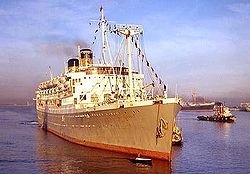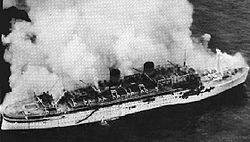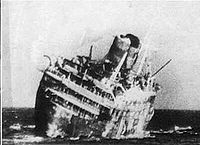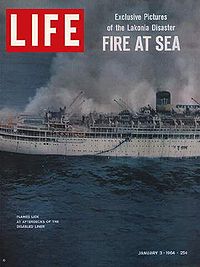TSMS Lakonia
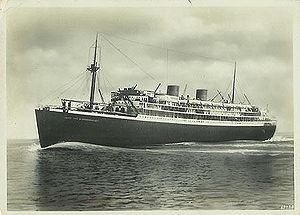 An early photo of the Johan van Oldenbarnevelt | |
| Career | |
|---|---|
| Name: | Johan van Oldenbarnevelt |
| Owner: | Netherland Line |
| Operator: |
Netherland Line 1930 - 1939 Holland America Line 1939-1945 Netherland Line 1946 - 1963 Greek Line 1963 |
| Route: |
Amsterdam and the Dutch East Indies Amsterdam – Batavia |
| Builder: | Nederlandse Scheepsbouw Maatschappij of Amsterdam |
| Launched: | 3 August 1929 |
| Completed: | 13 March 1930 |
| Decommissioned: | 3 February 1963 |
| Refit: |
1941 as a troopship 1946 restored to ocean liner status 1951 1958 1963 |
| Fate: | Sold to the General Steam Navigation Company of Greece and renamed TSMS Lakonia |
| Career | 50px |
| Name: | TSMS Lakonia |
| Owner: | General Steam Navigation Company of Greece |
| Port of registry: | Greece |
| Acquired: | 8 March 1963 |
| Fate: | Burned in a fire at sea 22-24 December 1963 and sank while under tow 29 December 1963 |
| General characteristics | |
| Class and type: | Ocean liner |
| Tonnage: | 19,040 tons |
| Length: | 609 feet (186 m) |
| Beam: | 74.8 ft |
| Decks: | 7 |
| Installed power: | two Sulzer diesel engines |
| Propulsion: | two propellers |
| Capacity: |
As built:
|
The TSMS Lakonia, originally named MS Johan van Oldenbarnevelt, was an ocean liner and troop ship that operated for over 30 years, before burning on December 22, 1963 with high loss of life.
Contents
Construction
The MS Johan van Oldenbarnevelt was built in Amsterdam at the Nederlandse Scheepsbouw Maatschappij, dockyard 194. The ship was launched on August 3, 1929 and construction was completed on March 13, 1930. She was powered by two propellers and two Sulzer diesel engines and had a maximum speed of 19 knots (35 km/h). The ship was 609 feet (186 m) long and measured 19,040 gross tons. The Johan van Oldenbarnevelt originally could accommodate 770 passengers: 366 in first class, 280 in second, 64 in third and 60 in fourth class. She could also carry as many as 360 crewmen. The ship had seven passenger decks and could carry 9,000 tons of additional cargo.
Ship history
As the Johan van Oldenbarnevelt
She was originally operated by the Netherland Line, and sailed between Amsterdam and the Dutch East Indies for nine years. Along with her sister ship, the Marnix van St. Aldegonde, the Johan van Oldenbarnevelt was the largest Dutch ship at the time she was built. She was the eighty-ninth ship ever built for the Netherland Line.
The ship was built as a luxury liner. Famed artist Carel Adolph Lion Cachet and sculptor Lambertus Zijl designed the ship’s teak and marble interior, as well as her many statues, mosaics, tapestries and chandeliers.
World War II service
At the outbreak of World War II in 1939, the Johan van Oldenbarnevelt was chartered by the Holland America Line and re-registered in Batavia, Indonesia. She was used as a cargo ship on the Batavia to New York City route. On January 20, 1941, she was registered as an allied troop ship, and was converted for duty at the Harland and Wolff shipyard. Managed by the Orient Line, she could carry a maximum of 4,000 troops. Her port of registration was Willemstad, Curaçao. After servicing India, Singapore and Penang, she finally returned to her home port of Amsterdam on February 13, 1946.
Her sister ship, the Marnix van St. Aldegonde, also served as a troop ship. She was torpedoed and sunk by German aircraft off the Algerian coast, and all 3,000 troops and crew were saved by rescue ships.
Postwar service
After a refitting, the Johan van Oldenbarnevelt returned to service on the Amsterdam – Batavia route in 1946. Indonesians were fighting for their independence from the Netherlands at this time. The ship ferried Dutch troops returning home to Europe from Indonesia for several years.
By 1950, the political climate in Indonesia had become so unstable that the ship was withdrawn from the East Indies service. She was switched to the Amsterdam – Australia service and departed on her first voyage to Australia on September 2, 1950. She serviced Australia and New Zealand for the next twelve and a half years, with occasional service to Canada and the United States.
The Australia run was an instant success, and 1951, the Johan van Oldenbarnevelt was put into dry-dock in Amsterdam for refitting. She was refurbished to carry 1,414 passengers in a one-class configuration. Her lounges were restored to their original state of luxury, and additional passenger facilities were installed. Eight lifeboats were added, bringing her total number of boats to 24.
On January 23, 1952, the ship left for Australia and was forced to return to Amsterdam after four small fires were discovered on board. The fires were quickly extinguished. Arson was suspected, but no suspects were ever arrested.
The Johan van Oldenbarnevelt was refitted again in 1958 at a cost of AU$800,000. The refitting was carried out by the Amsterdam Dry Dock Company and took three months to complete. Accommodation was reduced to 1,210 passengers. Three luxury suites were added, as well as a nightclub, cinema, gift shop, promenade lounge and second swimming pool. All public rooms were refinished and restored. The main mast was relocated to atop the bridge, and the decks were extended aft. Her funnels were heightened, given rounded tops and painted yellow and black. Her black hull was re-painted gray.
The ship was assigned to her new port, Southampton, England, on April 2, 1959. She offered round-the-world service, making stops in Australia, New Zealand, Bermuda and New York City. She was now marketed as a cruise ship, instead of a passenger liner.
The Johan van Oldenbarnevelt left on her last round-the-world voyage for the Netherland Line on June 30, 1962. She arrived in Sydney, Australia on February 3, 1963 and was decommissioned by the Netherland Line that day, ending a 33-year career for that shipping line. She then sailed for Genoa, Italy, and arrived on March 7, 1963.
As TSMS Lakonia
On March 8, 1963, the Johan van Oldenbarnevelt was sold to the General Steam Navigation Company of Greece. Her decks and public rooms were re-named and the aft swimming pool was enlarged. Twelve additional cabins were built, and air conditioning was installed throughout the ship. Her hull was painted white, and her tonnage grew to 20,314 tons. Most importantly, the ship's name was changed to TSMS Lakonia.
The ship was operated by the Ormos Shipping Company (also known as the Greek Line) and offered service from Southampton to the Canary Islands. She departed Southampton on her first voyage as Lakonia on April 24, 1963. She proved immensely popular, and the Greek Line planned 27 cruises for 1964. From December 9 to December 13, 1963, she underwent another minor upgrade. A new pneumatic fuel injection system was installed. Cabins were redecorated, and the kitchen and pantry were completely remodeled.
The Lakonia was outfitted with a number of safety features. She carried 24 lifeboats capable of holding 1,455 people. The ship had an automatic fire alarm system and two fire stations with specialized firefighting equipment. There were lifejackets for every person on board and an extra 400 stowed on deck.
In addition to Lakonia, the Greek Line also operated the larger Arkadia and Olympia.
The fire
The Lakonia departed Southampton on December 19, 1963 for an 11-day "Christmas Cruise" of the Canary Islands. Her first scheduled stop was to be the island of Madeira. There were 646 passengers and 376 crewmen on board: a total of 1,022 people. All but 21 of the passengers were British citizens, and the crew members were mostly Greek and German. The captain of the Lakonia was 53-year-old Mathios Zarbis.
The crew had conducted a boat drill a week before, and the ship passed a safety inspection by the British Ministry of Transport 24 hours prior to sailing. The ship carried a Greek certificate of seaworthiness. Passengers participated in a boat drill on December 20.
The first three days of the cruise were uneventful. Passengers played shuffleboard and deck tennis by day and enjoyed banquets and dances by night. The cruise brochure promised "absolute freedom from worry and responsibility".
At around 11:00 p.m. on December 22, a steward noticed thick smoke seeping under the door of the ship's hairdressing salon. Upon opening the door, he found the room completely ablaze, and the fire rushed into the hallway toward the staterooms. He and another steward attempted to fight the flames with fire extinguishers, but the fire was spreading too fast to be contained. One of the men ran to notify the ship's purser, Antonio Bogetti.
Fire alarms sounded, but too softly to be heard by most passengers. "The fire alarm bell was so weak that it sounded like someone calling the waiter to ask for tea," one survivor later told reporters. An alarm went off on the bridge, pinpointing the fire’s location. The ship was about 180 miles north of Madeira.[A][1][2]
At the time the blaze was discovered, most of the passengers were in the ship's ballroom, called the Lakonia Room, dancing at the "Tropical Tramps' Ball". Passengers began to notice the smell of smoke, but most dismissed it as strong cigar smoke. Captain Zarbis, who had been notified of the fire, attempted to make an announcement on the ship's intercom system, but it had been disabled by the blaze. As smoke began to fill the ballroom at about 11:30, the band stopped playing and cruise director George Herbert ushered the frightened passengers to the boat deck. The upper deck was ablaze within 10 minutes.
Many of the passengers who had been asleep in their cabins found themselves unable to escape the fire. Some passengers were told to go to the main dining room to await instructions, but most ignored this order, since the dining room lay directly in the path of the fire.
At 11:30 p.m., the ship's chief radio officer Antonios Kalogridis sent out the first distress call: "Fire spreading up. Prepare evacuation on ship." At midnight, a second distress call was sent out: "We are leaving the ship. Please immediately give us assistance. Please help us." Kalogridis sent out the last call at 12:22 a.m., just before the wireless room caught fire: "SOS from Lakonia, last time. I cannot stay anymore in the wireless station. We are leaving the ship. Please immediate assistance. Please help."
A six-man fire crew attempted to fight the blaze, but the fire spread too quickly to be contained. The pressure boilers began to explode, filling the rooms and hallways with thick, black smoke, and the suffocating passengers were forced on deck. The ship's purser gave the order to abandon ship shortly before 1:00 a.m. Dazed passengers made their way to the lifeboats, some in their pajamas and others still wearing their jewelry and eveningwear.
A few crew members went below decks to try to save passengers from their burning cabins. The ship's swimming pool attendant and a steward lowered themselves over the side of the ship by rope to pull trapped people from portholes.
Evacuation of the ship was extremely difficult. Some lifeboats burned before they could be lowered. Two of the lifeboats were swamped, spilling their occupants into the sea; one when it was lowered only by one end, and the other when its davits broke off. Chains had rusted in many of the davits, making boats difficult or impossible to move. In the end, just over half of the lifeboats made it safely away from the Lakonia, some of them less than half full. Several people who dived overboard struck the side of the ship on the way down, killing them before they hit the water.
Passengers were angered when the wireless operator left the ship in a launch with a nurse and two musicians. Kalogridis later testified that he had left to rescue people from the water. He did not return to the ship because the current pushed the launch away, he explained. Passengers also claimed that some of the crewmen took advantage of the chaos to loot staterooms.
When all of the boats were away, there were still people adrift in the water and over 100 people left on board the burning ship. The Lakonia continued to burn fiercely and was rocked by violent explosions. Those who remained on board flocked to the glass-enclosed Agora Shopping Center at the stern of the ship. After several hours, the flames closed in on them, and they were forced to descend ropes and rope ladders into the ocean. The port and starboard gangways were lowered as well, and people walked down the gangways single file into the sea.

At 3:30 a.m., four hours after the first distress call, the 495-foot (151 m) Argentine passenger ship Salta arrived on the scene. The Salta, under the command of Captain José Barrere, had been on its way from Genoa, Italy to Buenos Aires. The 440-foot (130 m) British tanker Montcalm arrived half an hour later at 4:00 a.m. The majority of the survivors were saved by these two ships. The Salta rescued 475 people and took aboard most of Lakonia's lifeboats.
In the hours that followed, the Belgian ship Charlesville, the Brazilian freighter Rio Grande, the British passenger ship Stratheden and the Panamanian freighter Mehdi all arrived to take part in the rescue. Each of the rescue vessels dispatched boats to pluck survivors from the water. Also, four United States Air Force C-54 planes were sent from the Lajes Air Base in the Azores. The planes dropped flares, lifejackets, life rafts and survival kits to people in the water.
Rescue efforts were hindered by the fact that the Lakonia drifted for several miles during the evacuation. People in the water were dispersed over a 2 – 3-mile (4.8 km) area. Also, rescue ships were reluctant to get too near the Lakonia; there was a constant risk that the ship's 500 tons of fuel oil would explode.
A lifeboat was dispatched from the Charlesville shortly after daybreak to rescue Captain Zarbis, who was spotted pacing the decks of the still-burning ship. Zarbis was the last person to leave the Lakonia alive.
Most of the survivors were transported to Madeira, while others, including Captain Zarbis, were taken to Casablanca.
The aftermath
A total of 128 people died in the Lakonia disaster, of which 95 were passengers and 33 were crew members. Only 53 people were killed in the actual fire. The rest died from exposure, drowning and injuries sustained while diving overboard. One passenger who jumped from the ship cut her throat on her life jacket. After being rescued by the Montcalm, her injuries were treated by another passenger, Dr. Alan Leigh. Largely due to this incident, cruise ship passengers are now instructed how to hold their jackets if jumping from a height.
Crewmen from the British aircraft carrier HMS Centaur were able to board the Lakonia on December 24, once the flames had died down. Most of the bodies were recovered by the crew of the Centaur. By this time, the Lakonia was a charred, smoking hulk. Her superstructure had partially collapsed amidships, and the bridge and aft decks had caved in. There were holes blasted near the bow, and the ship was listing 10 degrees to starboard.
The Norwegian tugboat Herkules attached a tow line to the Lakonia at 5:30 p.m. on December 24. The Herkules, along with the Portuguese tugboat Praia da Adraga and two other tugs, set off for the British base at Gibraltar with the Lakonia in tow. Her list grew more severe each day, and at about 2:00 p.m. on December 29, the Lakonia rolled over onto her starboard side. She sank stern-first in only three minutes. The ship went down 230 miles (370 km) southwest of Lisbon, Portugal and 250 miles (400 km) west of Gibraltar.
The only color photographs ever taken of the Lakonia disaster ran in Life magazine on Jan. 3, 1964.[3] Life's photographic coverage of the event marked only the second time in history that a publication was able to offer hour-by-hour photographic coverage of a disaster at sea.[3] The first such coverage appeared on Aug. 6, 1956, when Life ran a series of photos of the SS Andrea Doria sinking.
The investigation
The Greek Merchant Marine Ministry launched a two-year investigation into the Lakonia disaster. The board of inquiry maintained that the Lakonia never should have passed safety inspections before sailing. Lifeboat davits were rusted and lockers containing lifesaving equipment failed to open. The drain holes in many lifeboats were without stoppers, so that passengers had to constantly bail water.
While a lifeboat drill had been conducted by the crew a week before the fateful voyage, only five of the boats had been lowered in the drill. All of the boats should have been tested, the board argued.
Charges of looting were dropped after extensive questioning. The crewmen maintained that they had only broken into cabins to search for extra lifejackets.
The board of inquiry issued a number of other charges. The order to abandon ship was given too late. Operations on deck were not supervised by responsible officers. The crew, despite a few cases of self-sacrifice, failed to rescue sleeping passengers from their cabins below decks.
Eight of the Lakonia's officers were charged with negligence. Captain Zarbis, his first officer and the ship’s security officer were charged with gross negligence. The other five men were charged with simple negligence.
The cause of the fire was ultimately determined to be a short circuit of faulty electrical wiring.
See also
Notes
- ^ The available sources do not specify whether these are statute miles or nautical miles.
References
- ↑ Marine Fire Prevention, Firefighting and Fire Safety. DIANE Publishing. 1994. pp. 46. ISBN 9780788104787. http://books.google.com/books?id=4Fp2NzVifn0C.
- ↑ Stilgoe, John R. (2003). Lifeboat. University of Virginia Press. pp. 3. ISBN 9780813922218. http://books.google.com/books?id=KvB6NPbSByAC.
- ↑ 3.0 3.1 Marchbanks, David. The Painted Ship: An Account of the Fire at Sea Aboard the Greek Liner Lakonia. London: Secker & Warburg, 1964.
